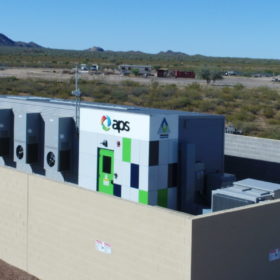
A series of failures triggered thermal runaway and an explosion at Arizona Public Service Electric's McMicken battery facility, according to two new reports that look at how to prevent similar disasters in the future.
From pv magazine USA
New details have emerged surrounding the Arizona Public Service Electric (APS) battery failure and corresponding explosion that hospitalized eight firefighters and one police officer in Surprise, Arizona, in April 2019.
Two recently published reports – one by APS, and the other by the Underwriters Laboratory Firefighter Safety Research Institute – reveal new details regarding the incident
“The suspected fire was actually an extensive cascading thermal runaway event, initiated by an internal cell failure within one battery cell in the BESS: cell pair 7, module 2, rack 15,” DNV GL Energy Insights said in the APS report. The cascading thermal runaway was likely caused by an internal cell defect – namely, abnormal lithium metal deposition and dendritic growth within the cell.
While the system’s clean agent fire suppression system began operating to contain the event, the system is designed to extinguish developing fires in ordinary combustibles, rendering it entirely ineffective against cascading thermal runaway. From there, the event spread through every cell and module in rack 15 of the system, via heat transfer, as it did not have adequate thermal barrier protections between battery cells. Such thermal barriers could have significantly prevented the spread.
Expansive thermal runaway produced a large quantity of gases, which created a flammable atmosphere within the system. Three hours after the event began, firefighters opened the system’s door, agitating the gases and allowing them to make contact with a heat source or spark that triggered the explosion.
In short, the two reports identified five root causes of the explosion:
- Internal failure in a battery cell initiated thermal runaway
- The fire suppression system was incapable of stopping thermal runaway
- Lack of thermal barriers between cells led to cascading thermal runaway
- Flammable off-gases concentrated without a means to ventilate
- The emergency response plan did not have extinguishing, ventilation, and entry procedures
According to APS, existing battery storage system safety standards and procedures only acknowledge cascading thermal runaway as a risk. These standards do little to prohibit thermal runaway, and fail entirely to address the risk of non-flaming heat transfer to neighboring cells, modules and racking. According to the utility, those same standards focus on the means to manage a fire, but provide no solutions to restrict or slow cell-to-cell and module-to-module thermal runaway.
The Firefighter Safety Research Institute report came to the same conclusions regarding what led to the event, but it also outlines steps that can be taken in order to mitigate the likelihood of a similar failure in the future.
- Basic Firefighter, Officer, and HAZMAT training should emphasize ESS safety
- Research and full-scale testing should be conducted to understand the most effective and safest tactics for response to lithium-ion battery incidents
- Fire service personnel should define a conservative potential blast radius and remain outside of it while treating the event, until definitive tactics and guidance can be established
- Lithium-ion battery systems should incorporate gas monitoring that can be accessed remotely
- Additional plans for increased monitoring, safety standard development and communication between the battery system, operators and first responders
While these standards will take some time to develop, there is a pressing need for them sooner rather than later. APS has plans to install at least 850 MW of nearly identical batteries across Arizona in the near future. And the United States is now on track install as much as 2,500 MW of battery storage by 2023, according to data from the U.S. Department of Energy’s Energy Information Administration.
Lắp đặt điện mặt trời Khải Minh Tech
https://ift.tt/2X7bF6x
0906633505
info.khaiminhtech@gmail.com
80/39 Trần Quang Diệu, Phường 14, Quận 3
Lắp đặt điện mặt trời Khải Minh Tech
https://ift.tt/2ZH4TRU
Không có nhận xét nào:
Đăng nhận xét